Understanding and adhering to Department of Transportation (DOT) regulations is crucial for businesses in transportation and logistics, encompassing safety, security, and environmental protection. Select DOT Compliance includes industry-specific elements like vehicle maintenance, driver qualifications, and cargo handling guidelines, with unique requirements for hazardous materials transport and passenger carriers. A multi-faceted approach involving technology, staff training, clear protocols, regular audits, and staying updated on regulations ensures continuous compliance. Navigating complex DOT rules can be challenging, leading to costly fines; expert guidance is vital, especially in trucking industries, to implement effective strategies, enhance safety, reduce risks, and foster a culture of sustained Select DOT Compliance.
“Uncover expert insights into DOT regulations, a vital aspect of industrial compliance. This comprehensive guide navigates the complex landscape of Department of Transportation (DOT) standards, offering a tailored approach for diverse industries. From understanding key components to avoiding common pitfalls, we empower businesses with practical tips for seamless DOT adherence. Discover how professional guidance ensures long-term compliance, enhancing safety and operational efficiency in today’s regulated environment.”
- Understanding DOT Regulations: A Comprehensive Overview
- Key Components of DOT Compliance for Different Industries
- Practical Tips for Implementing and Maintaining DOT Standards
- Common Pitfalls and How to Avoid Them in DOT Compliance
- The Role of Expert Guidance in Ensuring Long-Term DOT Adherence
Understanding DOT Regulations: A Comprehensive Overview

Understanding DOT regulations is essential for any business involved in transportation and logistics. These rules, enforced by the Department of Transportation (DOT), are designed to ensure safety, security, and environmental protection throughout the supply chain. Compliance with DOT standards is crucial not just to avoid hefty fines but also to maintain operational efficiency and public trust.
The DOT’s regulations cover a wide range, including specific guidelines for transporting hazardous materials, strict record-keeping standards, and comprehensive rules on driver conduct and vehicle maintenance. Businesses must select DOT compliance strategies that align with their operations, from proper packaging and labeling of cargo to meticulous tracking and documentation. Implementing these measures fosters a culture of safety and helps maintain the integrity of the entire supply chain security measures.
Key Components of DOT Compliance for Different Industries

The key components of DOT (Department of Transportation) compliance vary across industries, but certain fundamental aspects are universally crucial. For instance, all industries must adhere to safety standards that include vehicle maintenance, driver qualifications, and hours-of-service regulations. These ensure the safe operation of vehicles and prevent fatigue among drivers, which is a significant concern in industries like trucking and logistics.
Additionally, each industry has specific requirements related to cargo handling, security, and reporting. For example, hazardous materials transport requires adherence to strict guidelines outlined in the Hazardous Materials Table, ensuring proper packaging, labeling, and documentation. In contrast, passenger carriers must focus on emergency procedures, accessibility, and maintaining accurate records of passengers and their belongings. Select DOT compliance involves a comprehensive understanding of these industry-specific rules alongside the broader international DOT transportation rules to ensure safe, legal, and efficient operations.
Practical Tips for Implementing and Maintaining DOT Standards

Implementing and maintaining Department of Transportation (DOT) standards is a multifaceted task that requires meticulous attention to detail. To ensure continuous DOT compliance, carriers should begin by selecting the appropriate safety technologies tailored to their operations. Integration of advanced technology like electronic logging devices (ELDs), collision avoidance systems, and driver monitoring solutions can significantly enhance transportation safety. Regular staff training on these technologies is crucial; ensuring everyone understands how to operate them effectively contributes to seamless implementation.
Beyond technology adoption, establishing clear internal protocols and fostering a culture of safety are essential. Regular audits and inspections should be conducted to identify and rectify any non-compliance issues promptly. Maintaining accurate records of training sessions, equipment maintenance, and safety protocol adherence is vital for demonstrating regulatory compliance during audits. Additionally, staying updated with the latest DOT regulations through continuous international trade compliance training ensures your business remains ahead of the curve in meeting evolving industry standards.
Common Pitfalls and How to Avoid Them in DOT Compliance

Many businesses, especially those involved in transportation, often find themselves navigating a complex web of regulations under the Department of Transportation (DOT). While adhering to these rules is essential for operations and safety, it’s not without its challenges. One of the most common pitfalls is misinterpreting or overlooking specific DOT compliance requirements, which can lead to costly fines and legal issues. For instance, ensuring proper training for employees and maintaining accurate records is crucial but easily overlooked, especially during periods of rapid growth.
To steer clear of such traps, businesses should invest time in thoroughly understanding the federal motor carrier safety administration (FMCSA) guidelines and regularly reviewing them as the regulations evolve. Regular audits and staying updated on changes in the DOT medical card renewal process are vital steps. Implementing robust cargo security and safety protocols not only complies with DOT standards but also enhances operational efficiency and reduces potential risks. By adopting a proactive approach, businesses can foster a culture of unwavering adherence to DOT compliance, ensuring smooth sailing through regulatory requirements.
The Role of Expert Guidance in Ensuring Long-Term DOT Adherence

Expert guidance plays a pivotal role in helping businesses and individuals navigate the intricate web of DOT regulations, ensuring long-term adherence. This is particularly crucial in industries like trucking, where safety is paramount. By enlisting professionals with extensive knowledge of DOT fatigue management regulations, companies can implement effective strategies to combat driver fatigue, a significant concern in the industry. These experts provide valuable insights into best practices for maintaining accurate records and utilizing driver performance monitoring systems, thereby enhancing overall operational safety.
Furthermore, they offer tailored advice on staying up-to-date with evolving safety regulations for the trucking industry, which is essential given the dynamic nature of legal requirements. Such guidance enables businesses to avoid costly compliance mistakes, reduces the risk of penalties, and fosters a culture of sustained DOT compliance. This proactive approach not only ensures legal adherence but also contributes to the overall well-being of drivers, fleets, and road safety.
In navigating the complex landscape of DOT regulations, expert guidance is an indispensable tool for ensuring long-term adherence. By understanding key components specific to various industries and implementing practical tips, businesses can sidestep common pitfalls. Incorporating these strategies into operational workflows not only facilitates compliance but also enhances safety standards across all sectors. When seeking a competitive edge in the market, selecting robust DOT compliance measures becomes a strategic imperative, setting the stage for sustained success within regulated environments.
